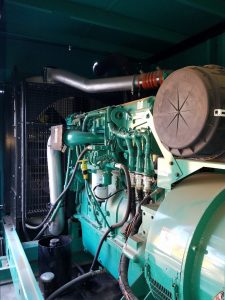Generator Basics: Diesel Particulate Filters (Generator DPF)
Since EPA emissions regulations worldwide have become tougher, many changes have been made involving diesel generator engines and the resulting exhaust gases. Though diesel produces one eighth the amount of carbon monoxide as a typical gasoline engine, it produces twenty times the amount of nitrogen oxide. Diesel exhaust is categorized as a Group 1 carcinogen, linked to both lung and bladder cancer.
The use of Ultra Low Sulfur Diesel fuel combined with EGR technology has greatly reduced the harmful emissions on stock generator engines. However, as Tier 4 Final compliance becomes mandatory, many older machines are unable to meet that requirement. Retrofitting with Diesel Particulate Filters (generator DPF) bring most units into compliance; removing at least 90 percent of the unwanted pollutants from the exhaust gases.
How does A Generator DPF work?
Usually mounted in place of a standard exhaust silencer, a DPF consists of a box or cylinder containing a catalytic substrate and a filter matrix made from cordierite, silicon carbide, ceramic or metal fibers. Exhaust is forced into the filter substrate, where particulates are collected and retained, and the cleaned exhaust released into the environment.
Regeneration
As the DPF collects more and more soot particulates over time, it obviously can become clogged. This can result in elevated back pressure; a condition which can cause catastrophic damage to a generator engine. Most DPF’s are cleaned through a process called regeneration. Regeneration uses high temperatures(1112 degrees F+) to effectively burn away the collected soot particles. According to Wiki: “This is done either passively (from the engine’s exhaust heat in normal operation or by adding a catalyst to the filter) or actively introducing very high heat into the exhaust system.”
Passive Regeneration
The majority of diesel engines used in generator sets would employ a passive mode of regeneration. In many cases, the operating temperature of a diesel generator engine will be high enough to maintain a state of continuous regeneration. In cases where the operating temperatures do not reach sufficient levels, then the introduction of nitrogen oxide as a catalyst in the filter material will aid in reaching the temperatures necessary to burn away the soot particulates trapped in the matrix. Thus, inspecting the DPF for clogging should be a regular part of your generator maintenance plan.
Passive regeneration systems are very popular as retrofits. This is because they do not require integration with the engine or an external source of power. Instead, they simply take advantage of the already heated exhaust gases.
Staying in Compliance
Though California has led the way with stringent emissions regulations, most states are tightening up on diesel engine pollution. Compliance with Tier 4 Final EPA standards is an unavoidable eventuality for owners and operators of diesel engined generator sets. Not doing so can result in heavy fines, forced upgrades and lost productivity. There are many high-quality aftermarket Diesel Particulate Filters available, often customized to specific makes and models.
For more information on EPA compliance, DPF’s and generator upgrades, please give us a call. We buy, sell and lease used, new and surplus generators.


